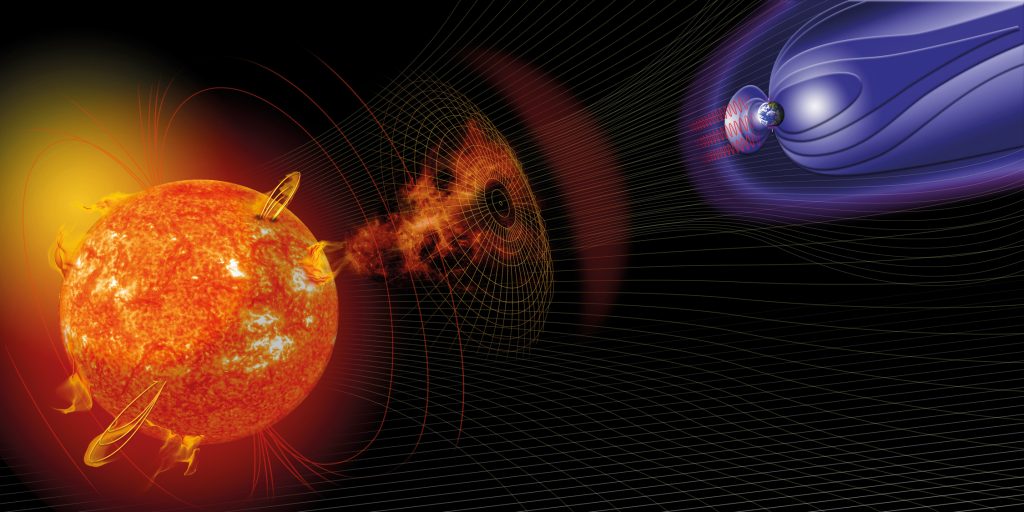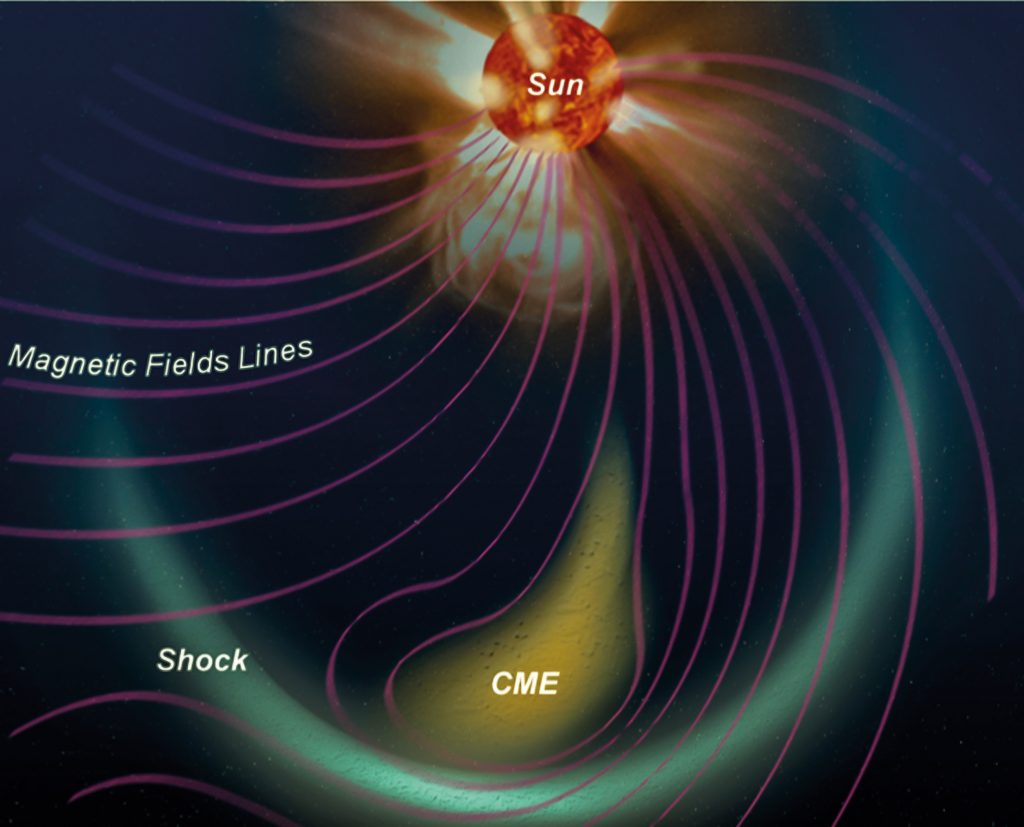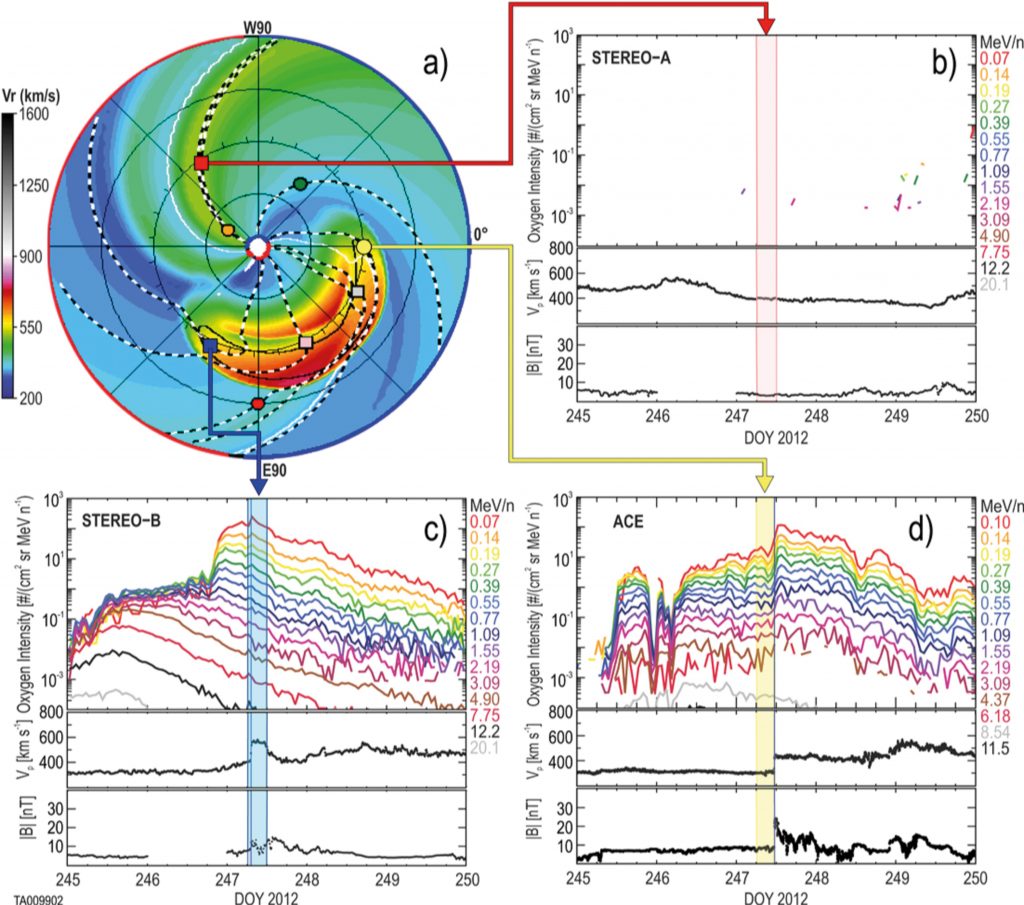Dr Robert Ebert – Pinpointing the Physics of Energetic Storm Particles Observed in Near Earth Orbit
When the Sun’s surrounding corona erupts, colossal streams of charged particles are ejected out into interplanetary space, and go on to interact with the material that resides there. Dr Robert Ebert at the Southwest Research Institute and his colleagues combine observations from spacecraft with the latest computer models to uncover the mysteries of these interactions. Their research focuses on advancing astronomers’ understanding of the highly energetic processes that play out in the void that comprises over 99% of the Solar System’s volume.
Energetic Storm Particle Events
Interplanetary space is home to vast numbers of charged particles, which spend most of their time being transported through the Solar System. Occasionally, however, large-scale astronomical events can drastically change their behaviour. Such events include energetic bursts of plasma originating from the Sun known as Coronal Mass Ejections (CMEs), which are thought to be caused by the intricate behaviours of the Sun’s magnetic field. When interplanetary ions interact with these CMEs, they become shocked, and are accelerated to extremely high energies.
Ions accelerated at shocks associated with CMEs observed near Earth are known as energetic storm particles (ESPs). Astronomers believe that these accelerations are likely affected by a variety of factors, including the speed, strength, orientation, and magnetic turbulence of the CME shocks that caused them. Currently, however, our understanding of the process is far from complete and requires further research.
When a CME interacts with the Earth’s magnetic field, it can release vast amounts of energy, creating particularly strong and beautiful aurora in the Earth’s polar regions, but it can also cause significant disruption to satellites and electrical transmissions, as well as health issues for astronauts.
Without a complete knowledge of the physics behind these events, attempts to prepare for them will be incomplete, making our global communications networks more vulnerable. To fill these gaps in our awareness, Dr Robert Ebert at the Southwest Research Institute acknowledges that a combination of detailed observations from spacecraft with sophisticated computer modelling is urgently needed.

Learning from Observations
Over the past few decades, astronomers have used observations of ESP events to make a variety of predictions about their connections with the properties of shocks caused by CMEs. For example, the range of energies to which particles become accelerated, known as their spectra, is thought to be dependent on the density of shocked interstellar material, while the orientation of the shock is predicted to have a strong influence on the abundances of the particles it contains. Furthermore, the properties of ESPs are believed to depend on magnetic turbulence ‘upstream’ from the shock.
In a 2016 study, Dr Ebert and his colleagues aimed to learn more about the properties of ESPs themselves, by observing them from two separate spacecraft. In their study, the craft took their observations at the same distance from the Sun as Earth’s orbit, but at different longitudes – or distances parallel to the Sun’s equator. By doing this, the researchers hoped to uncover longitudinal variations in the relationships between the properties of interplanetary shocks caused by CMEs, and ions of oxygen and iron, during ESP events.
Their discoveries included the fact that as ESP events progress, their intensities varied significantly between the measurements of each spacecraft. On the other hand, properties including shock speed, density, and magnetic field compression and orientation, showed little organisation with longitude. Yet despite these discoveries, a variety of properties remained unexplained, which called for a more detailed examination in future research.

Solar activity from events such as solar flares and coronal mass ejections can influence the space environment around Earth, and can affect both spaceborne and Earthbound resources such as satellites and power grids. CREDIT: NASA
Identifying Gaps in Understanding
Leading on from this study, Dr Ebert and his colleagues have identified a variety of areas that could potentially lead to new insights into the physical mechanisms underlying ESP accelerations by CME shocks. Several theories in the past have attempted to link the properties of energetic particles with those of local shocks in the interplanetary medium. So far, however, these efforts have been unable to precisely predict the intensities of ion accelerations indicative of ESPs. In addition, they haven’t yet consistently determined the spectra of ESPs, along with the overall abundances of the ions they contain.
In the face of these challenges, Dr Ebert and his colleagues aim to compare the properties of interplanetary shocks, turbulence, and source material, with the intensities, spectra, and ionic abundances of associated ESP events. To pinpoint the physical drivers of these ESP properties, they have identified three key questions, to be answered through analysis incorporating both computer models and spacecraft observations.
The first of their questions is: what is the relationship between locally observed shock properties, and ESP properties such as intensities, spectra, and abundances? The second is: how does magnetic turbulence situated upstream from the shock, and the presence of ions that act as ‘seeds’ for particle acceleration, affect the properties of ESPs? And finally: what is the cause of variability both between separate ESP events, and within individual events, as observed from longitudinally separated spacecraft?
By addressing each of these questions in turn, Dr Ebert hopes to advance astronomers’ current understanding of the physics that plays out as interplanetary particles are accelerated by CMEs. However, in order to find these solutions, another experimental step needs to be taken. Since the physical mechanisms that trigger particular ESP properties are so complex, and may depend on multiple parameters, the team has enlisted the help of a tool that many other branches of astronomy have turned to in recent years: the power of computer modelling.

Interplanetary shocks produced upstream of CMEs can accelerate ions and electrons to high energies. When observed near Earth, these high energy particles are called Energetic Storm Particles (ESPs).
Enlisting Computer Models
To answer their three questions, Dr Ebert and his colleagues now plan to use an advanced computer model named ‘Particle Acceleration and Transport in the Inner Heliosphere’ (PATH). The model is highly sophisticated, and has already been used by many astronomers studying the properties of the environment surrounding our host star during CMEs. Clearly, however, PATH would still be useless if it were not given the right instructions. In this case, Dr Ebert’s team plans to use ESP and CME shock data gathered by real spacecraft to act as PATH’s inputs.
With this setup, they are able to systematically vary the different aspects of shock acceleration within the model, and then observe their influence on the resulting ESP intensities, spectra and abundances. This allows them to isolate the CME properties responsible for particular physical aspects of ESP production and their properties. The researchers also acknowledge that PATH would allow them to model selected ESP events from the vantage points of different spacecraft, allowing them to identify the mechanisms responsible for longitudinal variations in some properties of ESPs, as observed by Dr Ebert in his 2016 study.
This modelling framework gives the researchers a suitable basis for laying out descriptions of what they needed to measure, the tasks these measurements would address, and the expected results of their analysis.
Advancing our knowledge of ESPs
The first of these questions regarded the relationship between the plasma and magnetic properties of shocks with those properties of the ESP event as a whole. Dr Ebert’s team predicts that solving this issue would require them to systematically study the influence of interplanetary shocks on ESP properties using the PATH model, and to survey several dozen ESP events within the solar cycle.
If carried out correctly, the team expects to identify whether the speed of interplanetary shocks, their strength as measured by density and magnetic field enhancements, and their orientation relative to the interplanetary magnetic field, can influence the intensities, energy spectra, and ionic abundances of ESP events.
The second question asks how magnetic turbulence and the presence of ions with energies above the nominal solar wind upstream of the shock may affect the properties of ESPs. Dr Ebert’s team uses spacecraft observations and the sophisticated modelling capabilities of PATH to identify the conditions under which upstream turbulence, and the energy spectra of seed particles, affect ESP intensities, spectra and abundances.
Finally, the third question considers why there are clear differences between different ESP events, and even between single events from the perspectives of different spacecraft. Dr Ebert’s team proposes that this could be answered by using PATH to model ESP events from the vantage points of different spacecraft that are longitudinally separated in space. They would then compare the results of the simulations with real spacecraft observations. The team expects that this would allow them to uncover the causes of variability in ESP intensities, spectra and abundances between these events.

Observations of CMEs, shocks and energetic particles from NASA spacecraft orbiting the Sun, along with simulations of these events, are used to study the physical processes that produce ESPs near Earth. CREDIT: The Astrophysical Journal
A Roadmap to Future Discoveries
Having set out these clear goals, Dr Ebert and his colleagues believe they have developed a strong basis for advancing our understanding of CME-driven ion accelerations. Their roadmap lays the foundations for a three-year research project, in which they will combine data analysis with the latest efforts in computer modelling.
By setting out these goals, the researchers have a reliable roadmap for uncovering the mysteries surrounding the colossal, highly energetic processes that play out in the vastness of space. With further research, they could also allow for developments of crucial safeguards to our global communications networks against the damaging effects of CMEs and the energetic particles associated with them.
Reference
https://doi.org/10.33548/SCIENTIA454
Meet the researcher

Dr Robert W. Ebert
Principal Scientist
Space Science and Engineering Division
Southwest Research Institute
San Antonio, TX USA
Assistant Adjoint Professor
Department of Physics and Astronomy
University of Texas at San Antonio
San Antonio, TX USA
Dr Ebert completed his PhD in Space Physics at the University of Texas at San Antonio in 2010. His research now focuses on the physics of plasma and energetic particles in interplanetary space and Jupiter’s magnetosphere. He is currently the plasma ion sensor lead for the Jovian Auroral Distributions Experiment on Juno and has contributed to the pre- and post-flight calibration of flight instruments on several NASA missions. He has recently developed SmallSat mission concepts to study the solar wind’s interaction with Jupiter’s magnetosphere and the space environment around Mars.
CONTACT
T: +1 210-522-2229
KEY COLLABORATORS
Maher Dayeh (Southwest Research Institute)
Mihir Desai (Southwest Research Institute)
Lan Jian (NASA Goddard Space Flight Center)
Gang Li (University of Alabama in Huntsville)
Charles Smith (University of New Hampshire)
FUNDING
NASA – Heliophysics Supporting Research (Grant)
NASA – Living with a Star Research (Grant)
FURTHER READING
RW Elbert, MA Dayeh, MI Desai, LK Jian, G Li, GM Mason, Multi-spacecraft analysis of energetic heavy ion and interplanetary shock properties in energetic storm particle events near 1au, The Astrophysical Journal, 2016, 831, 21.
MA Dayeh, MI Desai, RW Ebert, HA Elliott, A Farahat, K Kozarev, and G Li, What causes the variability in the properties of energetic storm particle (ESP) events?, 17th Annual International Astrophysics Conference, IOP Conference Series, Journal of Physics: Conf. Series 1100, 012008, (2018).
J Hu, G Li, S Fu, G Zank, and Z Ao, Modeling a single SEP event from multiple vantage points using the iPATH model, The Astrophysical Journal Letters, 854, L19 (2018).


Creative Commons Licence
(CC BY 4.0)
This work is licensed under a Creative Commons Attribution 4.0 International License. 
What does this mean?
Share: You can copy and redistribute the material in any medium or format
Adapt: You can change, and build upon the material for any purpose, even commercially.
Credit: You must give appropriate credit, provide a link to the license, and indicate if changes were made.
More articles you may like
Grandmothers: Innovation Through Tradition
Grandmother Project – Change through Culture (GMP) is an organisation dedicated to documenting the role of grandmothers and demonstrating the effectiveness of grandmother-inclusive strategies in improving the health and well-being of women, children, and adolescents. GMP’s groundbreaking work challenges conventional wisdom to transform community-based interventions in Africa and beyond, harnessing a powerful but often overlooked resource: the wisdom and influence of grandmothers.
Dr Robert Larkin | Cultivating Change to Improve Soil Health and Increase Potato Yield
Environmental quality and food production are facing the pressing challenges of climate change and global population growth. Dr Robert Larkin from the United States Department of Agriculture-Agricultural Research Service (USDA-ARS) and a team of plant scientists developed and tested a range of crop management systems to help overcome these compounding challenges. Their work is improving soil health and increasing the yield of potato crops, contributing to the future food security of nations.
Professor Giorgio Buttazzo | Artificial Intelligence and a Crossroads for Humanity
Where do we stand with artificial intelligence? Might machines take over our jobs? Can machines become conscious? Might we be harmed by robots? What is the future of humanity? Professor Giorgio Buttazzo of Scuola Superiore Sant’Anna is an expert in artificial intelligence and neural networks. In a recent publication, he provides considered insights into some of the most pressing questions surrounding artificial intelligence and humanity.
Dr Ralf Adam | New Technologies Shaping the Future of Oral Hygiene
Understanding the efficiency of various toothbrush technologies is essential for achieving optimal oral health. Dr Ralf Adam, who leads a dedicated team at Procter & Gamble in Germany, is keen to investigate the complexities of these technologies. His team have provided new insights into the best toothbrush types for plaque removal and the maintenance of gum health. By highlighting the importance of informed oral care decisions and ongoing investigations, this vital research works towards ensuring everyone can achieve a brighter, healthier smile.




